
In the dynamic world of data analytics consulting, establishing a well-defined data analytics strategy is paramount for any organization aiming to succeed. Whether you’re at the helm of a burgeoning startup or steering an established company, the ability to harness data effectively is transformative—streamlining decision-making, enhancing operational efficiency, and boosting customer engagement. This introduction will delve into the foundational frameworks and strategic steps essential for crafting and executing a robust data analytics strategy.
A solid framework is central to any effective data strategy. You might have encountered references to a data strategy framework from firms such as McKinsey, which highlights the structured approaches developed by industry leaders to aid businesses in their data-driven journeys. Such frameworks act as comprehensive roadmaps, outlining every phase from data gathering to its analytical applications, ensuring every data element serves a strategic objective.
Throughout this article, we will explore the critical elements of data analytics strategies, including drafting a data analytics strategy document and the importance of maintaining a clear data strategy roadmap. We will also introduce practical tools and examples, such as the data analytics strategy toolkit and various data analytics strategy examples, to illustrate how these concepts are applied in real-world settings.
If you’re aiming to refine your existing strategies or starting afresh, understanding the key pillars of a sound data strategy and the diverse frameworks available is incredibly beneficial. We will guide you through building and implementing a data analytics strategy that not only aligns with but also enhances your business objectives. Join us as we unfold these insights, equipping you with the knowledge to boost your analytical capabilities.
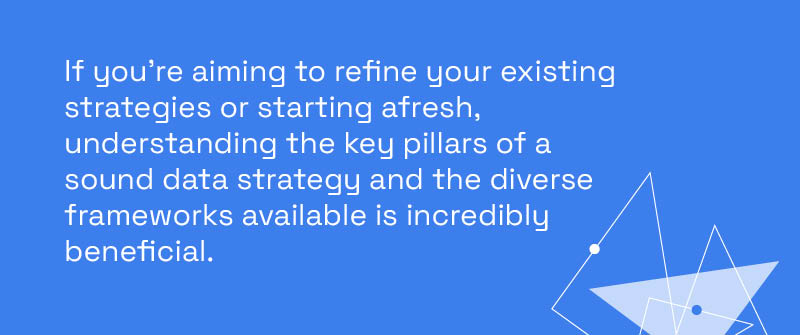
Why is a Data Analytics Strategy So Critical?
In the rapidly evolving landscape of data analytics consulting, a robust data strategy serves as the cornerstone for any organization striving to thrive. You may have come across references to a data strategy framework from renowned firms like McKinsey, emphasizing its significance in guiding businesses through their data-driven journeys. The pivotal role of a data strategy cannot be overstated, as it fundamentally transforms how organizations operate, make decisions, and engage with customers.
A well-defined data strategy ensures that every aspect of data management, from collection to analysis, is aligned with the organization’s strategic goals. This alignment not only streamlines decision-making processes but also enhances operational efficiency and fosters deeper customer engagement. Throughout this article, we’ve touched upon the critical elements of a data strategy, including the creation of a data analytics strategy document and the importance of a clear data strategy roadmap. Tools like Power BI and platforms like Microsoft Fabric, discussed in our earlier sections, illustrate the practical applications of a solid data strategy.
Moreover, a comprehensive data strategy encompasses meticulous data collection, efficient storage, and management, leveraging advanced tools for analysis, and adhering to stringent data governance and compliance standards. These elements, combined with the practical examples provided, underscore the transformative impact of an effective data strategy on business performance.
The implementation of insights derived from data analytics is another crucial aspect. Strategic decisions, driven by data, need continuous monitoring and refinement to ensure they align with the ever-evolving business environment. By integrating these strategic steps, organizations can harness the full potential of their data, turning it into a strategic asset that drives significant value.
What Is a Data Analytics Strategy?
A data analytics strategy is a comprehensive plan that outlines how a business will leverage data to achieve its strategic goals. What is data and analytics consulting? This involves not only selecting the right methodologies and personnel but also integrating powerful tools that can transform raw data into actionable insights. Among these tools, Power BI, a part of the data analytics strategy toolkit, plays a crucial role in enabling businesses to visualize data and uncover trends that inform strategic decisions.
Key Components of a Data Analytics Strategy
- Data Collection: The foundation of a robust analytics strategy begins with meticulous data collection. Identifying the necessary data types, sources, and collection methods is crucial to ensuring compliance with legal and ethical standards.
- Data Storage and Management: Efficient data storage and management are vital. Businesses must employ systems that ensure data is secure, scalable, and accessible. Microsoft’s cloud infrastructure, often referred to as Microsoft Fabric, provides a resilient environment for data handling, facilitating ease of access and robust data management capabilities.
- Data Analysis with Power BI: At the core of the data analytics strategy is the analysis process, where tools like Power BI come into play. Power BI enables users to perform deep statistical analysis, create rich visualizations, and generate comprehensive reports. Power BI consulting services can further assist businesses in customizing their use of the tool to fit their specific needs, optimizing the data analysis process for better insights.
- Data Governance and Compliance: Adhering to data governance and compliance standards is essential. This includes setting protocols for data usage, ensuring privacy, and maintaining security across all data touchpoints.
- Implementation of Insights: The ultimate aim of a data analytics strategy is the practical application of derived insights. Strategic decisions are made based on data-driven evidence, which are then continuously monitored and refined to enhance overall business performance.
By integrating tools like Power BI and utilizing platforms like Microsoft Fabric, organizations can dramatically enhance their data analytics capabilities. These technologies not only support the analytical process but also ensure that insights are accurate, timely, and actionable. This strategic integration empowers businesses to make informed decisions that drive success.
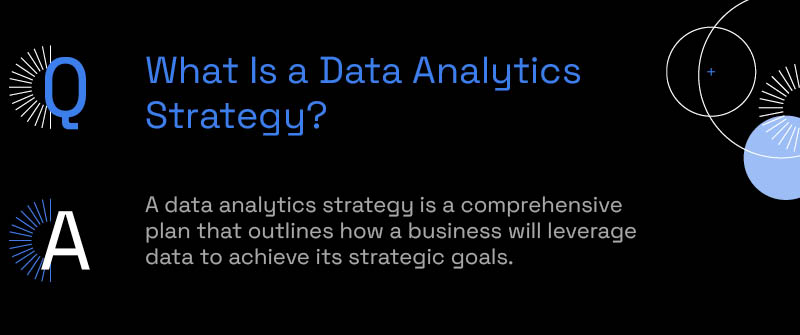
How Do You Plan an Analytics Strategy?
Planning an effective analytics strategy requires a methodical approach that aligns with your business goals and leverages the right technologies to gather, analyze, and act upon data. Here, we’ll break down the planning process into actionable steps, ensuring that organizations can harness the full potential of their data analytics initiatives.
- Define Business Objectives: The first step in planning your analytics strategy is to clearly define what you want to achieve. Are you looking to improve operational efficiency, enhance customer satisfaction, or increase revenue? Setting clear, measurable goals is crucial as it directs the focus of your analytics efforts.
- Select Appropriate Tools and Technologies: Choosing the right tools and technologies is essential for effective data analytics. For example, Power BI can be instrumental in visualizing data and gaining insights, while Microsoft Fabric provides a robust infrastructure for managing and storing data securely. Engaging with Power BI consulting services can help tailor the tool to your specific business needs, ensuring that your analytics capabilities are maximized.
- Data Collection and Integration: Collecting high-quality data is fundamental. This involves not only identifying relevant data sources but also ensuring the data is accurate and timely. Integration of this data into a unified system like Microsoft Fabric allows for more cohesive analysis and better insights.
- Develop Analytical Models: Once your data is integrated, developing analytical models comes next. These models will help you interpret the data and extract insights aligned with your business objectives. This step often involves statistical analysis, predictive modeling, and data mining.
- Implement and Continuously Improve: With the models and tools in place, the next step is to implement the strategy across your organization. This involves training teams, establishing data governance, and integrating insights into decision-making processes. Continuous improvement is critical; as business environments and technologies evolve, your analytics strategy must stay effective.
By meticulously planning each step, organizations can ensure that their data analytics strategies are not only reflective of their current needs but are also scalable and adaptable to future demands. This structured approach enables businesses to transform data into a strategic asset that drives significant value.
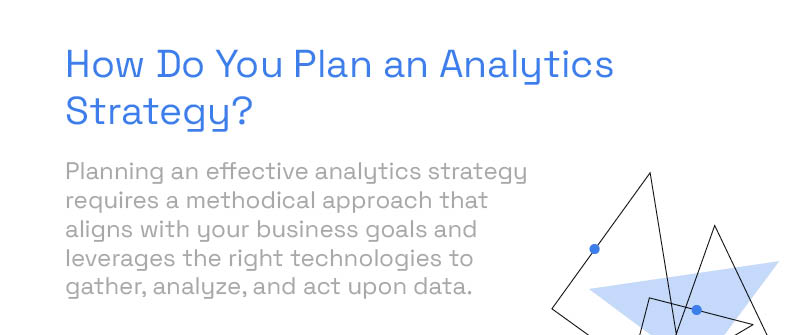
How Do You Write a Data Analytics Strategy?
Writing a data analytics strategy involves detailing the specific methods and processes by which your organization will use data to drive decision-making and achieve business objectives. This document serves as a blueprint guiding all analytics-related activities within your company. Here are key elements to consider when writing your strategy:
- Establish Clear Objectives: Start by clearly defining what your data analytics strategy aims to achieve. These objectives should align with your broader business goals and be specific, measurable, achievable, relevant, and time-bound (SMART).
- Detail Data Collection and Management: Outline the types of data your organization requires, where it will come from, how it will be collected, and the standards for ensuring data quality and integrity. Include details on how data will be stored using robust platforms like Microsoft Fabric, which ensures security and scalability.
- Choose the Right Analytical Tools and Techniques: Specify the tools and technologies that will be used to analyze the data. Highlight the use of Power BI for its powerful visualization capabilities and discuss how Power BI consulting can enhance its functionality to suit your specific needs. Detail the analytical techniques that will be employed, such as statistical analysis, machine learning, or predictive modeling.
- Implement Data Governance: Describe the policies and procedures for data governance to ensure compliance with regulations and to maintain data privacy and security. This section should clearly articulate who has access to data, how data usage is monitored, and how data integrity is maintained.
- Monitoring and Evaluation: Define how the effectiveness of the data analytics strategy will be monitored and evaluated. Include key performance indicators (KPIs) that will be tracked and the processes for periodic review and revision of the strategy.
- Action Plan: Provide a step-by-step action plan that outlines how the strategy will be implemented across the organization. This includes timelines, responsibilities, and resources needed.
A well-written data analytics strategy document is comprehensive yet clear and practical. It not only guides your team in implementing the strategy but also serves as a communication tool to align all stakeholders with your organization’s data-driven vision.
How Do You Write a Data Strategy Document?
Writing a data strategy document is an essential step for any organization looking to harness the power of its data effectively. This document serves as a roadmap detailing the policies, procedures, and technologies that will be utilized to manage and leverage data as a strategic asset. Below are the critical components to include in a data strategy document:
- Define the Scope and Vision: Begin with a clear definition of the scope of your data strategy. What aspects of the business will it cover? What are the long-term visions and the immediate goals? Establishing this foundation helps align the data strategy with the broader business objectives.
- Data Management Framework: Detail the framework for managing data within your organization. This includes data collection, storage, processing, and sharing. Explain how technologies like Microsoft Fabric will be used to ensure data is stored securely and is easily accessible. Mention the roles and responsibilities of different teams or individuals in managing data.
- Technology and Tools: Outline the specific technologies and tools that will be employed to execute the data strategy. Include a discussion on why Power BI is chosen for data visualization and analysis and how Power BI consulting can optimize its use. Mention any other critical software or hardware components that will support the data strategy.
- Data Governance and Compliance: Describe the data governance structure. Who will oversee the data strategy? What are the policies regarding data privacy, security, and quality? Include how the organization will comply with relevant laws and regulations.
- Implementation Strategy: Detail the implementation plan, including timelines, key milestones, and resource allocation. Discuss how changes will be communicated and managed within the organization.
- Monitoring and Continuous Improvement: Set out the methods for monitoring the performance of the data strategy. Identify key performance indicators (KPIs) that will help measure success and areas for improvement. Explain the process for updating the data strategy document as the business and technology landscapes evolve.
A comprehensive data strategy document is crucial for ensuring that all aspects of data management are addressed and aligned with the organization’s overall strategy. It should serve as a living document that guides the data practices of the company and evolves with its growth.
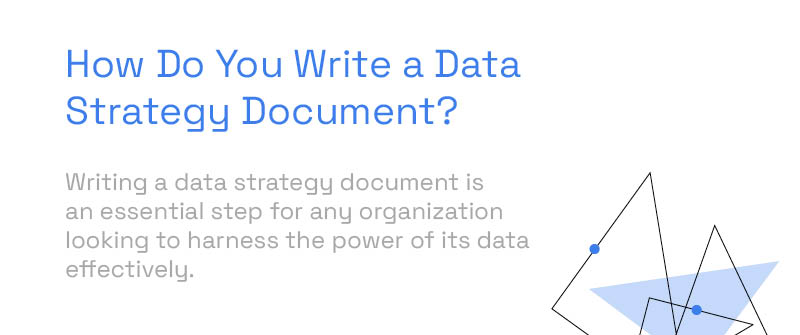
What Is a Data Strategy Framework?
A data strategy framework is a structured approach to managing and utilizing data effectively within an organization. It serves as a blueprint, guiding businesses in creating, implementing, and maintaining their data strategy. This framework helps ensure that data acts as a strategic asset, supporting business objectives through informed decision-making. Here’s an overview of the core components that typically make up a data strategy framework:
- Vision and Goals: Begin by defining the vision for data usage within the organization. What strategic goals does the company aim to achieve through its data? This vision should align with the overall business strategy and specify how data will contribute to success.
- Data Management Principles: Outline the principles for managing data, including acquisition, validation, storage, protection, and processing. Detail how data will be handled securely and efficiently, with platforms like Microsoft Fabric ensuring robust data management and scalability.
- Analytical Tools and Technologies: Specify the tools and technologies that will support the data strategy. Highlight the role of Power BI in analyzing data and generating insights, and mention the value of Power BI consulting services in customizing solutions to fit the organization’s needs.
- Governance and Compliance: Develop a comprehensive governance structure to oversee data management practices. This includes roles and responsibilities, data quality standards, and compliance with data protection regulations.
- Implementation Plan: Describe the steps for implementing the data strategy, including timelines, key deliverables, and stakeholder responsibilities. This plan should be clear and actionable, ensuring that all team members understand their roles in the process.
- Monitoring and Revision: Establish metrics for monitoring the effectiveness of the data strategy. Include regular reviews and updates to the strategy to adapt to new challenges and opportunities in the data landscape.
By adopting a structured data strategy framework, organizations can ensure that their data practices are coherent, compliant, and ultimately conducive to achieving strategic business objectives. This systematic approach facilitates effective data management and leverages technology to enhance decision-making and organizational performance.
What Are the 4 Pillars of Data Strategy?
A solid data strategy is built on four foundational pillars that ensure data is leveraged effectively to drive business growth and innovation. Understanding these pillars is crucial for any organization looking to optimize its data management practices and analytics capabilities. Here’s a closer look at each of these core pillars:
- Data Quality: High-quality data is essential for generating reliable insights. This pillar focuses on ensuring the accuracy, completeness, consistency, and timeliness of the data collected. Implementing rigorous data validation processes and continuously monitoring data quality are vital steps. Organizations need to establish clear guidelines for data entry, update procedures, and regular audits to maintain the integrity of their data.
- Data Governance: Data governance involves setting policies and procedures that control data access and usage within an organization. It ensures that data is managed securely and in compliance with regulatory requirements. This pillar also covers roles and responsibilities regarding data management, establishing who can access, modify, or share data. Effective governance is necessary to prevent data breaches and ensure transparency in data handling.
- Data Intelligence: This pillar emphasizes the use of analytical tools and technologies to extract actionable insights from data. Tools like Power BI play a crucial role here, allowing businesses to visualize data trends and inform strategic decisions. Engaging Power BI consulting services can enhance the capabilities of this tool, tailoring its functionality to meet specific business needs and maximize the value of data intelligence.
- Data Culture: Fostering a data-driven culture is the final pillar. It involves promoting data literacy among all employees and encouraging the use of data in everyday decision-making processes. Cultivating a culture where data is valued and effectively used can lead to greater innovation and efficiency across the organization.
Together, these pillars form a robust foundation for any data strategy, ensuring that data not only supports but drives business objectives. By focusing on these key areas, organizations can enhance their data management practices and create a competitive edge in their industry.
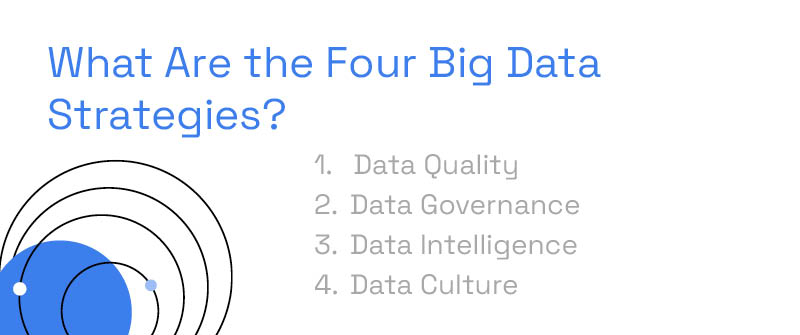
What Are the Four Big Data Strategies?
Big data has transformed the way businesses operate and make decisions. Understanding and implementing the right strategies can significantly enhance an organization’s ability to process and benefit from large volumes of data. Here are four major strategies that are pivotal in harnessing the power of big data:
- Data Consolidation: The first strategy involves consolidating data from various sources into a single, coherent framework. This approach allows for more effective data management and analysis. Using platforms like Microsoft Fabric can facilitate the integration and handling of large datasets, ensuring that data is accessible and manageable across the organization. Consolidation helps in creating a unified view of information, which is crucial for accurate analysis and decision-making.
- Data Accessibility: Ensuring that data is easily accessible to stakeholders within the organization is essential. This strategy focuses on democratizing data access so that teams across various departments can make data-driven decisions. Implementing tools like Power BI enhances data accessibility by providing intuitive and powerful visualization features that make complex data more understandable for non-technical users.
- Data Diversification: Diversification involves expanding the variety of data types and sources used by the organization. By incorporating diverse data sets, businesses can gain a more comprehensive view of their operations and market dynamics. This strategy encourages innovation and helps companies identify new opportunities by analyzing trends and patterns that were not previously visible.
- Real-time Analytics: The ability to perform analytics in real-time is a powerful strategy for businesses that need to make quick decisions based on the latest data. Real-time analytics tools can process large volumes of data instantaneously, providing immediate insights that are essential for dynamic environments. This capability is particularly valuable in industries like finance, retail, and telecommunications, where conditions can change rapidly.
These four big data strategies are key to maximizing the potential of big data. By effectively implementing these strategies, organizations can improve operational efficiency, enhance customer experiences, and drive innovation. Each strategy contributes to building a more resilient and agile business capable of thriving in today’s data-driven world.
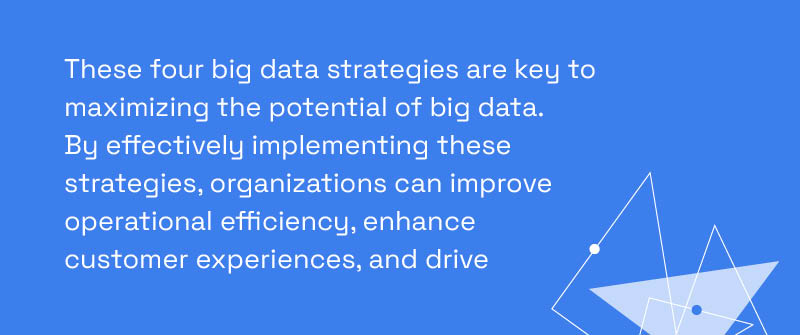
As you can see, developing and implementing a comprehensive data analytics strategy is vital for any business aiming to leverage data for strategic advantage. From defining clear business objectives, selecting the right tools to establish robust data governance, and fostering a data-driven culture, each element plays a crucial role in shaping a successful data strategy.
A well-articulated data analytics strategy not only streamlines processes but also empowers your teams to extract the maximum value from your data, driving growth and innovation. However, crafting and maintaining an effective strategy can be complex, involving a careful balance of technology, governance, and organizational culture.
If you’re ready to jumpstart your data project or advance your analytics capabilities, consider partnering with an expert. At P3 Adaptive our data analytics team specializes in tailoring data analytics strategies to fit your unique business needs. Our team of experts is equipped with the knowledge and tools to help you navigate the complexities of data analytics, from initial strategy development to execution and ongoing support with your data and analytics initiatives. Contact us today to see how we can help you achieve your data-driven goals and turn insights into action.
Get in touch with a P3 team member